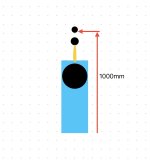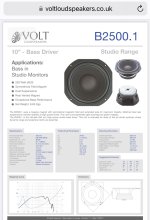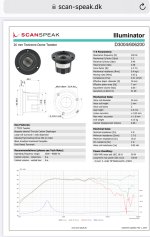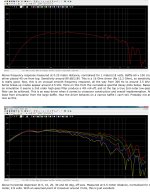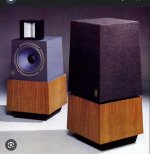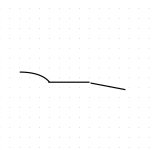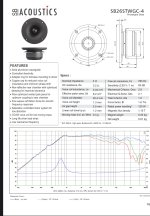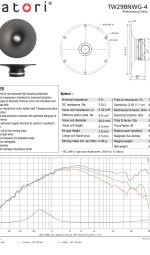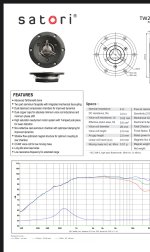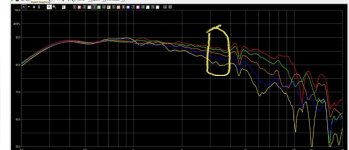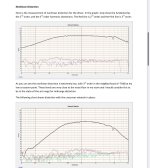Yep, I'm aware of 'em.🙂
I've used LR 96dB/oct linear-phase routinely, on dozens of projects for about 10 years.
Problems they overcome/advantages:
They allow drivers to be used exclusively in their "sweet bandwidth" where mag is flat, and consequentially phase is naturally flat too.
They reduce lobing by reducing the frequency range of critical summation.
They are damn easy to implement, because impulse peaks align which are easy to identify.
Unlike IIR filters that must have initial impulse rises properly identified. Almost impossible with low frequencies.
They don't change time and phase relationships when changing the crossover frequency (again, like IIR does)
They reduce phase rotations, and make group delay between driver sections equate simply to time-of-flight between sections.
And they rock, because they make it easy for anyone to achieve excellent results. 😀
No more slippery-slope, hoo-doo voodo IIR crossovers to contend with.
Here's an example of a 5-way measured today.
Individual sections mag and impulses, with xovers at 100, 250, 750, & 4000Hz, all 96 dB/pct.
All below indoors 1m no gating. Sub and main spliced.
View attachment 1327336
Measured full speaker. 1/48th
View attachment 1327337
You go and good luck, jheoaustin !
Thanks! The plots are impressive. Just out of curiosity, what do you mean by LR linear-phase? I thought there were only IIR version of LR filters.
You can have same slope as IIR but with compensated phase behavior.
Hence things like 16pole ( 96db/octave) Linkwitz riley compensated...
'Brickwall' linear phase have different curve in the 'knee'.
You can even compensate phase for a bass reflex port if 'correctly' aligned ( you can predict it's behavior).
Hence things like 16pole ( 96db/octave) Linkwitz riley compensated...
'Brickwall' linear phase have different curve in the 'knee'.
You can even compensate phase for a bass reflex port if 'correctly' aligned ( you can predict it's behavior).
I think the above post is a good way to take stock.
I look forward to Jheaustin providing some more insights into his needs. I think an understanding of his journey in loudspeakers would also help us understand what the next project might look like.
Of course sometimes we don’t understand the technical needs. This is why l illustrated that we are all different as listeners
How we listen to original performers (when we have the opportunity)
Front row
10 seats back
Middle row
Rear row
For my orchestral concert attending, I prefer to sit in row F to K, A being closest to the stage. I don't have much experience with smaller venues...
JH> Mostly classical, especially symphonic ones very loud. My new audiophile friend said I was the loudest listener he's ever met, though we met someone listening as loud or maybe even louder, pretty soon after he said that. 🙂The kind of music you listen to ?
A list of your prior and current loudspeakers
A summary of what you liked and didn’t like about them ?
Probably doesn't make much sense as I was clueless until I started using room correction with current one around 2006/7. But FWIW:
Wharfedale Delta 30
Musical Fidelity MC-4
Royd Sintra
ProAc Studio 200
This Wilmslow kit
I think the worst was MC-4 with untamed metal dome tweeter, or I failed to tune... For other speakers, I didn't have much complaint as I had been really clueless about good sound. I learned a lot through the room correction S/W and later attending the world-class performance at great halls like SF Davies hall.
What you want more of?
More open, still sweet treble. Measurement-wise less off-axis high-frequency drop. I think current Scanspeak 9500 is not that great in terms of off-axis response.
More natural bass? I think cheating with SVS 13" sub is giving me a lot, but there could be a bit of setback in subjective feeling. A 13" woofer seemed to sound better from my audio friend's DIY speakers.
Better look? My wife keeps complaining... lol
What you want less off?
At the original performance what is it that triggers your emotions about the sound you hear ?
Many different things... Direct feeling of sound, obviously not through electrical/mechanical systems. Sometimes its huge energy burst at tutti that the best audio systems struggle to imitate or recreate. I am just too lousy in English to properly express my feelings...
The melody?
The rhythm of the tune?
The timing of drums and percussion musical instruments
Solo vocal, chorus
What do you tend to focus on at home when listening?
There is no right or wrong to any of your responses.
Most of the time, not too much focus on some specific audio or sound things. But some specific sound or phrases at a particular part of the music draws my attention. Hard to describe, sorry.
Hmm.
For most of the thing you depict i would rather focus on your room than on loudspeakers but... you can't expect to have same mix of Early Reflection in domestical room than in a (huge) theater ( it's dimension related and/or geometry/shape related, as well as a mix of absorbing material/redirecting of wavefront).
And don't expect 'room correction' to be of any help regarding this, Early Reflection can only be treated by physical treatment ( acoustic treatment).
You could try to implement an RFZ but... in a domestical room for long ER ( >20ms with -20db attenuation)... it's even difficult in 'large' dedicated control room... and by large i mean bigger than 60m2 or in the 200m3 vicinity...
Imo best bet is with narrow radiating loudspeaker ( waveguide/horn) and implementing an RFZ.
Iow the inverse of what you are trying to achieve.
For most of the thing you depict i would rather focus on your room than on loudspeakers but... you can't expect to have same mix of Early Reflection in domestical room than in a (huge) theater ( it's dimension related and/or geometry/shape related, as well as a mix of absorbing material/redirecting of wavefront).
And don't expect 'room correction' to be of any help regarding this, Early Reflection can only be treated by physical treatment ( acoustic treatment).
You could try to implement an RFZ but... in a domestical room for long ER ( >20ms with -20db attenuation)... it's even difficult in 'large' dedicated control room... and by large i mean bigger than 60m2 or in the 200m3 vicinity...
Imo best bet is with narrow radiating loudspeaker ( waveguide/horn) and implementing an RFZ.
Iow the inverse of what you are trying to achieve.
Last edited:
For my orchestral concert attending, I prefer to sit in row F to K, A being closest to the stage. I don't have much experience with smaller venues...
JH> Mostly classical, especially symphonic ones very loud. My new audiophile friend said I was the loudest listener he's ever met, though we met someone listening as loud or maybe even louder, pretty soon after he said that. 🙂
Probably doesn't make much sense as I was clueless until I started using room correction with current one around 2006/7. But FWIW:
Wharfedale Delta 30
Musical Fidelity MC-4
Royd Sintra
ProAc Studio 200
This Wilmslow kit
I think the worst was MC-4 with untamed metal dome tweeter, or I failed to tune... For other speakers, I didn't have much complaint as I had been really clueless about good sound. I learned a lot through the room correction S/W and later attending the world-class performance at great halls like SF Davies hall.
More open, still sweet treble.
Measurement-wise less off-axis high-frequency drop.
More natural bass? I think cheating with SVS 13" sub is giving me a lot, but there could be a bit of setback in subjective feeling. A 13" woofer seemed to sound
Sometimes its huge energy burst at tutti that the best audio systems struggle to imitate or recreate.
But some specific sound or phrases at a particular part of the music draws my attention.
Hmm. I’ve had a look at your drivers and your comments.
Your tweeter is definitely out of date.
I would not change everything at once so l suggest keep using the ATC mid for now.
On the bass that could be your using the SVS sub. You are obviously reaching for more bass and lower because you’re using the SVS.
Is the Volt 2500.1 in a sealed enclosure?
Okay l fed it all into the super computer
This is what l suggest :
Tack it in two stages. The reason is it you change everything it might confuse you.
The mid treble step
Then later the bass step
The tweeter
https://www.scan-speak.dk/datasheet/pdf/d3004-606200.pdf
Your current tweeter has fero fluid. That idea went out of fashion a long time ago. This is a thin carbon tweeter of varying thickness. I think it’s a better material (close to beryllium) for high frequencies. Mount the tweeter like the B&W 801 D4 atop the mid dome. This should make the highs more airy.
Midrange
Retain the ATC dome for now. Place it in a tube with a round over if possible. Keep it well above the bass enclosure.
The crossover
Take 7 individual measurements around your listening position of the tweeter and then the dome mid.
Then average them and make a driver correction curve for each driver.
Apply the correction and set about creating your FIR crossover filters
Of the mid kid still isn’t doing it for you my suggestion is to try the Purifi 6.5 in midrange. Don’t search for anything else. This is likely the best mid on the planet.
I think the larger radiating area is likely to project better for HiFi listeners as apposed to near field monitors
Woofer step.
I would keep your existing Woofer ams used in the recommended vented enclosure. Driven actively it will perform better. If your running it sealed stop doing this. Use the 40L enclosure.
Assess the bass ouput. If you need more bass add a side 12 inch Volt woofer.
Attachments
I have found a very good set of measurements and technical information on the ATC mid dome in this link
https://studio-hifi.com/images/ATC75-150S_JeffBagby.pdf
Jeff Bagby indicates that the short horn is a diffraction control mechanism and upper mid
Frequency off active control.
This is interesting because it might mean the driver can be mounted free standing. I recommend some investigating of different baffles. But of this driver can be used on a narrow baffle without additional baffle control this greatly simplifies the baffle requirement.
This leaves the mounting and baffle for the tweeter.
It may be prudent to consider a wave guide if your final choice of tweeter does not include a wave guide cup in the flange.
https://studio-hifi.com/images/ATC75-150S_JeffBagby.pdf
Looking at Troels measurements it’s likely the off axis response on the mid dome can be controlled with a steep crossover slope. There will be a lack off continuity on the off axis response with the tweeter due to the smaller dome diameter.
However if you can cross at 3.8 khertz l believe the off axis response will correspond to a number of high quality 29mm tweeters. Particularly those with a wave guide. The built in wave guide will negate fabrication efforts for diffraction control (like your ATC dome)
Anyway, this is my wrap on this because l see that with a complete understanding of the ATC dome and your preferences that the solution may be not be that complicated. It’s about fine tuning, optimisation of the best of what you have with a new tweeter.
The use of dsp with FIR will greatly enhance the optimisation
https://sbacoustics.com/wp-content/uploads/2020/05/SATORI-TW29DN.pdf
This tweeter with a wave guide may be a good match to the ATC mid dome at 3.8 khertz
https://sbacoustics.com/wp-content/uploads/2020/05/SB26STWGC-4.pdf
https://sbacoustics.com/wp-content/uploads/2022/09/SATORI-TW29BNWG-8.pdf
https://studio-hifi.com/images/ATC75-150S_JeffBagby.pdf
Jeff Bagby indicates that the short horn is a diffraction control mechanism and upper mid
Frequency off active control.
This is interesting because it might mean the driver can be mounted free standing. I recommend some investigating of different baffles. But of this driver can be used on a narrow baffle without additional baffle control this greatly simplifies the baffle requirement.
This leaves the mounting and baffle for the tweeter.
It may be prudent to consider a wave guide if your final choice of tweeter does not include a wave guide cup in the flange.
https://studio-hifi.com/images/ATC75-150S_JeffBagby.pdf
Looking at Troels measurements it’s likely the off axis response on the mid dome can be controlled with a steep crossover slope. There will be a lack off continuity on the off axis response with the tweeter due to the smaller dome diameter.
However if you can cross at 3.8 khertz l believe the off axis response will correspond to a number of high quality 29mm tweeters. Particularly those with a wave guide. The built in wave guide will negate fabrication efforts for diffraction control (like your ATC dome)
Anyway, this is my wrap on this because l see that with a complete understanding of the ATC dome and your preferences that the solution may be not be that complicated. It’s about fine tuning, optimisation of the best of what you have with a new tweeter.
The use of dsp with FIR will greatly enhance the optimisation
https://sbacoustics.com/wp-content/uploads/2020/05/SATORI-TW29DN.pdf
This tweeter with a wave guide may be a good match to the ATC mid dome at 3.8 khertz
https://sbacoustics.com/wp-content/uploads/2020/05/SB26STWGC-4.pdf
https://sbacoustics.com/wp-content/uploads/2022/09/SATORI-TW29BNWG-8.pdf
Attachments
Last edited:
That ATC dome is expensive but it certainly measures really well.
On the active ATC monitors I have heard vocals are really beautiful.
Its Mms / Bl ratio of 2.23g / Bl of 8.46 is outstanding, the best I have ever seen in cones or domes... For me this is the most important TS stat.
The superb CSD graph ultra low distortion and high sensitivity are all linked to this ultra low Mms and high Bl ratio.
On the active ATC monitors I have heard vocals are really beautiful.
Its Mms / Bl ratio of 2.23g / Bl of 8.46 is outstanding, the best I have ever seen in cones or domes... For me this is the most important TS stat.
The superb CSD graph ultra low distortion and high sensitivity are all linked to this ultra low Mms and high Bl ratio.
Totally
In an active system good drivers end up sounding more vivid if that makes sense.
That vividness translates to a high level of realism. I think this with a new tweeter will make significant advances in the subjective performance.
In an active system good drivers end up sounding more vivid if that makes sense.
That vividness translates to a high level of realism. I think this with a new tweeter will make significant advances in the subjective performance.
Last edited:
Hi, seems much too simplistic view on things. While Bl and/or Mms might sometimes correlate with any measured data or audible qualities, sometimes it would not I think.
If you look bit further how drivers work, for example Bl value is not absolute as in datasheet, but varies with voice coil position / excursion, which is how it makes non-linear distortion, thus the static value Bl in TS parameters doesn't correlate in anyway with Bl related distortion, be it high or low. See klippel Bl(x) measurements to see how Bl behaves with any particular driver.
Also Mms is not directly linked to anything in CSD or distortion plots, while it is one measure (weight) of the moving parts it doesn't tell anything about how the moving parts resonate / flex / breakup with frequency and excursion, which again would be the thing that shows in graphs.
At least thats my understanding, likely also limited as I'm not professional on transducers. It is likely true that ATC dome sounds better than something else, it just is impossible to condence the performance into one or two numbers.
If you look bit further how drivers work, for example Bl value is not absolute as in datasheet, but varies with voice coil position / excursion, which is how it makes non-linear distortion, thus the static value Bl in TS parameters doesn't correlate in anyway with Bl related distortion, be it high or low. See klippel Bl(x) measurements to see how Bl behaves with any particular driver.
Also Mms is not directly linked to anything in CSD or distortion plots, while it is one measure (weight) of the moving parts it doesn't tell anything about how the moving parts resonate / flex / breakup with frequency and excursion, which again would be the thing that shows in graphs.
At least thats my understanding, likely also limited as I'm not professional on transducers. It is likely true that ATC dome sounds better than something else, it just is impossible to condence the performance into one or two numbers.
Last edited:
Edit time over: since construct of dome mid is totally different than similar sized cone mid, a woofer with same Bl and Mms as the dome would likely sound and measure very different. This logically means Bl and Mms datasheet numbers do not explain sound and measurements, as it's more complicated, everything affects sound and measurements.
I guess I understand both arguments. What I didn't come up with or say was that, 4-way design allows the use of the best FR of each driver in terms of everything including its dispersion. So the dispersion of even the higher frequency drivers are fairly wide(less directional peak or lobbing?), so kind of forms smooth or acceptable radiation band in the entire audible band. Does this make any sense?
Hi, Sorry, I'm not really understanding what you mean.....
My 'big picture' way at looking at directivity matching between multi-way sections, is that every radiator has a pattern of its own to begin with.
And the that beginning radiator pattern gets further altered (narrowed) by whatever baffle, waveguide, horn, etc it's mounted on.
So, in a sense, even direct radiators are "waveguides", like shown below.
And flat baffles are 180 degree "waveguides".
So again staying big picture, it seems to me matching driver sizes and baffle widths for each driver section, to flow together smoothly, is the name of the game for conventional flat-baffle multi-way designs.
Ime, getting that good acoustic design correct, pretty much mandates the relatively small ranges of acceptable xover frequencies between each set of driver sections.
If the acoustic design has pattern transition problems, my guess is low order xovers are going to hide them better than high.
With a very good acoustic design, my experience is high order-works better by narrowing the frequency range of xover induced lobing.
My turn to say, make sense? 🙂
Last edited:
Thanks! The plots are impressive. Just out of curiosity, what do you mean by LR linear-phase? I thought there were only IIR version of LR filters.
Welcome, and hi again 🙂
FIR filters can replicate any from of IIR filters (both frequency magnitude and phase).
So any named IIR filter, either with IIR's phase rotation, or without as linear-phase, is available.
For instance, here is a FIR version of a LR 48 dB/oct low-pass with normal IIR phase rotation,
And then same LR48 linear phase.
The radiation patterns in #532 show that through the crossover region the small driver has a radiation pattern that changes little with frequency but the large driver has a radiation pattern that changes significantly through the crossover region. This means if you want the weighted sum of the two patterns to be a constant width or changing smoothly with frequency then the crossover slopes need to be curved and not straight like analogue ones as shown in #533. FIR filters can be used to achieve this and is one of their significant advantages over analogue filters (and digital filters mimicking analogue).
OK I appreciate the OP has little interest in this sort of thing for his project but how to go about designing a wide beamwidth 4 way to a high standard is an interesting project. Is anyone aware of previous DIY efforts with narrow baffles and FIR filters to control the radiation pattern? One or two of Keele's publications are likely relevant (someone linked to one earlier) but a brief google found no obvious DIY efforts.
OK I appreciate the OP has little interest in this sort of thing for his project but how to go about designing a wide beamwidth 4 way to a high standard is an interesting project. Is anyone aware of previous DIY efforts with narrow baffles and FIR filters to control the radiation pattern? One or two of Keele's publications are likely relevant (someone linked to one earlier) but a brief google found no obvious DIY efforts.
This is why l suggested looking at wave guide on the tweeter in terms the owner can understand
Looking at the patterns of the ATC mid dome it spreads apart much earlier than a flat face plate because of the short wave guide.
This means it’s best to match it with a tweeter which has a wave guide to optimise the continuity between the mid dome and the tweeter patterns.
None of this is rocket science when observed visually.
See the attachments below.
The ATC dome pattern spreads to about 4 db relative to on axis at 3Khertz referring to 0, 10, 20, 30, 40 degrees.
Therefore the objective is to match these patterns to a tweeter at the cross over point
Moving back to 2 khertz would place the cross over in a critical part of the hearing range. All is not lost however.
Because you want low diffraction the mid dome has this built into it with the short waveguide.
Taking this benefit you can apply it to a tweeter with a waveguide. What is apparent when looking at the off axis patterns of a tweeter with a wave guide is that they are also spread.
By my eye about 3.6 khertz would be a good place to cross over to a tweeter waveguide.
When combined the off axis pattern should be smooth.
An additional point is that the owner does not necessarily need to have a ruler flat response in-room. Depending on the room acoustics a smooth taper above 2 khertz is appropriate with constant directivity. The build up of high frequency reverberant energy is best balanced with low freq shelf EQ below 100 hertz. We do this in the case of the JBL M2 clones because that wave guide has very wide directivity
I prefer to outlines these concepts visually on a forum to make it easier to interpret. I also believe in KISS in diy. Simple solutions to complex problems often work best in audio.
In diy we are not loudspeaker designers in the sense that we don’t do this all day every day and nor do we have an acoustic test chamber and two decades of experience. So we need an explanation of the underlying concepts. Over thinking details can easily lead to confusion and miss direction. The advantage is in diy we don’t need to listen to the marketing department or the accountant.
The above approach avoid the need to fabricate low diffraction baffles. To finish the industrial design a grill cloth stretched over a frame like the vintage ESS AMT 1 might work.
When proportioned appropriately this would compliment the tower form factor.
Edit In the ATC patterns the 30 degree lines is in blue which is hard to see.
Looking at the patterns of the ATC mid dome it spreads apart much earlier than a flat face plate because of the short wave guide.
This means it’s best to match it with a tweeter which has a wave guide to optimise the continuity between the mid dome and the tweeter patterns.
None of this is rocket science when observed visually.
See the attachments below.
The ATC dome pattern spreads to about 4 db relative to on axis at 3Khertz referring to 0, 10, 20, 30, 40 degrees.
Therefore the objective is to match these patterns to a tweeter at the cross over point
Moving back to 2 khertz would place the cross over in a critical part of the hearing range. All is not lost however.
Because you want low diffraction the mid dome has this built into it with the short waveguide.
Taking this benefit you can apply it to a tweeter with a waveguide. What is apparent when looking at the off axis patterns of a tweeter with a wave guide is that they are also spread.
By my eye about 3.6 khertz would be a good place to cross over to a tweeter waveguide.
When combined the off axis pattern should be smooth.
An additional point is that the owner does not necessarily need to have a ruler flat response in-room. Depending on the room acoustics a smooth taper above 2 khertz is appropriate with constant directivity. The build up of high frequency reverberant energy is best balanced with low freq shelf EQ below 100 hertz. We do this in the case of the JBL M2 clones because that wave guide has very wide directivity
I prefer to outlines these concepts visually on a forum to make it easier to interpret. I also believe in KISS in diy. Simple solutions to complex problems often work best in audio.
In diy we are not loudspeaker designers in the sense that we don’t do this all day every day and nor do we have an acoustic test chamber and two decades of experience. So we need an explanation of the underlying concepts. Over thinking details can easily lead to confusion and miss direction. The advantage is in diy we don’t need to listen to the marketing department or the accountant.
The above approach avoid the need to fabricate low diffraction baffles. To finish the industrial design a grill cloth stretched over a frame like the vintage ESS AMT 1 might work.
When proportioned appropriately this would compliment the tower form factor.
Edit In the ATC patterns the 30 degree lines is in blue which is hard to see.
Attachments
Last edited:
Mms and BL can indicate the maximum sound power of the driver, but can not guarantee low distortion. Low distortion is more about product of an optimization of motor and surround, which sometimes shows in Le parameters. And in the high level, low distortion is also the product of vented voice coil to disperse heat.
Hi, Sorry, I'm not really understanding what you mean.....
My 'big picture' way at looking at directivity matching between multi-way sections, is that every radiator has a pattern of its own to begin with.
And the that beginning radiator pattern gets further altered (narrowed) by whatever baffle, waveguide, horn, etc it's mounted on.
So, in a sense, even direct radiators are "waveguides", like shown below.
And flat baffles are 180 degree "waveguides".
View attachment 1327870
So again staying big picture, it seems to me matching driver sizes and baffle widths for each driver section, to flow together smoothly, is the name of the game for conventional flat-baffle multi-way designs.
Ime, getting that good acoustic design correct, pretty much mandates the relatively small ranges of acceptable xover frequencies between each set of driver sections.
If the acoustic design has pattern transition problems, my guess is low order xovers are going to hide them better than high.
With a very good acoustic design, my experience is high order-works better by narrowing the frequency range of xover induced lobing.
My turn to say, make sense? 🙂
To me it does.
That said i'm not absolutely sure low order xover slope help to hide transition problems. Or if it does it can induce some other side effect nasty's.
Dunlavy's are interesting to study as they achieve this through clever acoustical design/Xover/driver choice. But you already know that Mark.
Of course like most design which target accuracy to source they often sound unimpressive ( at first) and kind of boring. In fact they translate what is in the record, nothing more nothing less( at least they seems)...
In an active system good drivers end up sounding more vivid if that makes sense.
That vividness translates to a high level of realism. I think this with a new tweeter will make significant advances in the subjective performance.
It's interesting pov.
I 'activated' many loudspeakers ( ranging from my own 'mains' to PA) and to me it always sound like a veil is took off and the loudspeaker become agnostic to level change ( some passive loudspeakers sound good at a given spl, less so lower or higher, by going active it's way less obvious).
I never noticed this vividness.
I will try to compare with my mains and Tannoy both of which i kept the passive crossover and see if i notice it now i'm biased.
In a monitoring situation damping on the woofer by removing the inductors and the mid range - removal of a series capacitor helps maintain accurate piston movements.
Actively driven removes thermal issues on the dcr and impedance with passive networks.
If you read through that link Jeff discusses the various TL parameters in detail and outlines their significance. My take away is that the ATC dome likes a low source impedance due to the low mechanical damping with a high QMS of 13.
In my experience it’s difficult to accurately model a driver on TL parameters from a manufacturer or simple small signal test. Leap LMS with the VI box allows more accurate models.
None the less l find Jeff’s comments quite credible. Purifi have re-defined measurements of driver distortion components in recent times.
My final comment is that rocking of the voice coil in large dome radiators is a known factor to distortions. ATC are to my knowledge the only one offer dual spiders and a 6mm peak Linear X max in a 75mm dome radiator. The voice coil is 3.5mm in a long gap with a Peak Xmax of 6.00mm. This under hung motor in an inherently low distortion masterpiece.
My understanding is the coil is always in the gap.
In the quote below the facts speak for themselves:
Quote
“I measured the electro-mechanical parameters of the ATC SM75-150S driver. The sample submitted to me had a fairly high Re of almost 11 Ohms, so it likely called a 16 ohm driver. (I believe a lower impedance 8
The one parameter that stands out for this midrange is the very high Qms value of 13, which means there is very little mechanical damping of the driver's resonance (mechanical losses are very low). The high Qms results in an impedance peak at Fs of 248 Ohm. This would indicate that the driver is not suitable for a first order electrical filter, but use of a properly designed second order electrical filter, especially one with an L-Pad resistor network will easily compensate for this impedance peak. My sample had a measured Fs of 282 Hz and a Qts (actually a sealed Qtc) of .577, for a nice well-damped second order roll-off.”
Actively driven removes thermal issues on the dcr and impedance with passive networks.
If you read through that link Jeff discusses the various TL parameters in detail and outlines their significance. My take away is that the ATC dome likes a low source impedance due to the low mechanical damping with a high QMS of 13.
In my experience it’s difficult to accurately model a driver on TL parameters from a manufacturer or simple small signal test. Leap LMS with the VI box allows more accurate models.
None the less l find Jeff’s comments quite credible. Purifi have re-defined measurements of driver distortion components in recent times.
My final comment is that rocking of the voice coil in large dome radiators is a known factor to distortions. ATC are to my knowledge the only one offer dual spiders and a 6mm peak Linear X max in a 75mm dome radiator. The voice coil is 3.5mm in a long gap with a Peak Xmax of 6.00mm. This under hung motor in an inherently low distortion masterpiece.
My understanding is the coil is always in the gap.
In the quote below the facts speak for themselves:
Quote
“I measured the electro-mechanical parameters of the ATC SM75-150S driver. The sample submitted to me had a fairly high Re of almost 11 Ohms, so it likely called a 16 ohm driver. (I believe a lower impedance 8
The one parameter that stands out for this midrange is the very high Qms value of 13, which means there is very little mechanical damping of the driver's resonance (mechanical losses are very low). The high Qms results in an impedance peak at Fs of 248 Ohm. This would indicate that the driver is not suitable for a first order electrical filter, but use of a properly designed second order electrical filter, especially one with an L-Pad resistor network will easily compensate for this impedance peak. My sample had a measured Fs of 282 Hz and a Qts (actually a sealed Qtc) of .577, for a nice well-damped second order roll-off.”
Attachments
About the Atc dome liking low impedance i wonder?
I've heard them driven by current drive amplifier in one of the studio i worked in and outcome were very good imo ( for an ATC dome 😉 ).
Some members here talked about it too for a long time. I think one Englishman close to Atc once said this is the kind of solution Atc choosen for some active monitors.
I never had the guts to open the scm110a to check what they used on this one.
So i don't know. If going active i think it's a solution worth trying, especially coupled to dsp.
There is worst than a Firstwatt F1 or F2 to drive the mid no? Or an F4 maybe...? 🙂
I've heard them driven by current drive amplifier in one of the studio i worked in and outcome were very good imo ( for an ATC dome 😉 ).
Some members here talked about it too for a long time. I think one Englishman close to Atc once said this is the kind of solution Atc choosen for some active monitors.
I never had the guts to open the scm110a to check what they used on this one.
So i don't know. If going active i think it's a solution worth trying, especially coupled to dsp.
There is worst than a Firstwatt F1 or F2 to drive the mid no? Or an F4 maybe...? 🙂
Last edited:
My advice to the owner is that his quest is about refinement and not necessarily starting from a clean piece of paper.
A few tips
You already have an excellent mid driver (that l trust you can re use).
The refinement is deployment of a more recently designed tweeter that will fit in and complement the ATC dome in key spatial performance criteria.
The other refinement is in the use of active crossover. This will enable exacting voicing of the system tonal balance. You can dial in the voicing from your arm chair to a much higher degree of precision to the point all the drivers “sing” as one.
Subtle shifts of +-0.5 db are the increments to obtain lock - in of the drivers and absolute L+R driver level balance.
The L+R balance with each driver is critical to opening up the sound stage and imaging. This is because the ear maps both phase and Loudness for accurate localisation.
We all know about stereo pot channel balance. Applying this to a multi way loudspeakers is critical. Otherwise you can end up having the left mid dome up +1 db and the right mid dome down -1 db if your drivers not accurately measured in the nearfield.
The differential is 2 db squewed in on direction (the Left) while the tweeter might be the other way around (the Right).
It makes a real difference to the imaging and apparent openness of a system.
A differential within +- 0.5 db or better should be a goal in a high performance multi way system. Phono stages are 0.+-0.25 db across the audio band.
I have personally found this out with the JBL 4 way systems.
Final tip
A drop of Nelson Pass’s red matter in the form of negative phase 2nd order harmonic distortion and you can have a deep or a forward sound stage.
The world is now your oyster
A few tips
You already have an excellent mid driver (that l trust you can re use).
The refinement is deployment of a more recently designed tweeter that will fit in and complement the ATC dome in key spatial performance criteria.
The other refinement is in the use of active crossover. This will enable exacting voicing of the system tonal balance. You can dial in the voicing from your arm chair to a much higher degree of precision to the point all the drivers “sing” as one.
Subtle shifts of +-0.5 db are the increments to obtain lock - in of the drivers and absolute L+R driver level balance.
The L+R balance with each driver is critical to opening up the sound stage and imaging. This is because the ear maps both phase and Loudness for accurate localisation.
We all know about stereo pot channel balance. Applying this to a multi way loudspeakers is critical. Otherwise you can end up having the left mid dome up +1 db and the right mid dome down -1 db if your drivers not accurately measured in the nearfield.
The differential is 2 db squewed in on direction (the Left) while the tweeter might be the other way around (the Right).
It makes a real difference to the imaging and apparent openness of a system.
A differential within +- 0.5 db or better should be a goal in a high performance multi way system. Phono stages are 0.+-0.25 db across the audio band.
I have personally found this out with the JBL 4 way systems.
Final tip
A drop of Nelson Pass’s red matter in the form of negative phase 2nd order harmonic distortion and you can have a deep or a forward sound stage.
The world is now your oyster
- Home
- Loudspeakers
- Multi-Way
- 4-way instead of 3-way?
